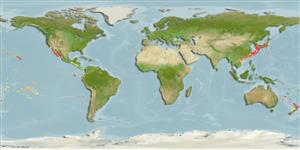>
Anguilliformes (Eels and morays) >
Muraenidae (Moray eels) > Muraeninae
Etymology: Gymnothorax: Greek, gymnos = naked + Greek, thorax, -akos = breast (Ref. 45335); ypsilon: ypsilon after the 20th letter of the Greek alphabet, in reference to the Y-shaped dark bars often found on this species (Ref. 10659).
More on authors: Hatooka & Randall.
Environment: milieu / climate zone / depth range / distribution range
Ökologie
seewasser demersal; tiefenbereich 110 - 185 m (Ref. 58302). Subtropical
Pacific Ocean: southern Japan and the Hawaiian Islands.
Size / Gewicht / Alter
Maturity: Lm ? range ? - ? cm
Max length : 89.0 cm TL Männchen/unbestimmt; (Ref. 35990); 77.6 cm TL (female)
Kurzbeschreibung
Morphologie | Morphometrie
Afterflossenstacheln 0; Afterflossenweichstrahlen: 151 - 154; Wirbelzahl: 141 - 153. A species of Gymnothorax of moderate length. Dorsal fin moderately high, its origin before gill opening. Anus before mid-body. Jaw teeth sharp and uniserial. Body creamy light brown with 26-35 distinct, narrow, dark crossbars extending onto fins (some bars on most specimens Y-shaped). Anterior part of head uniformly light brown. Anal fin with a white margin (Ref. 10659). MVF 5-56-149 (Ref. 35990).
Benthic (Ref. 58302). Minimum depth from Ref. 106682.
Life cycle and mating behavior
Geschlechtsreife | Fortpflanzung | Ablaichen | Eier | Fecundity | Larven
Böhlke, E.B. and J.E. Randall, 2000. A review of the moray eels (Anguilliformes: Muraenidae) of the Hawaiian Islands, with descriptions of two new species. Proc. Acad. Nat. Sci. Philad. 150:203-278. (Ref. 35990)
IUCN Rote Liste Status (Ref. 130435)
Bedrohung für Menschen
Harmless
Nutzung durch Menschen
Mehr Information
NamenSynonymeMetabolismusRäuberÖkotoxikologieFortpflanzungGeschlechtsreifeAblaichenSpawning aggregationFecundityEierEientwicklung
Alter/GrößeWachstumLänge-GewichtLänge-LängeLängenhäufigkeitenMorphometrieMorphologieLarvenLarven Pop.Dyn.RekrutierungDichteBRUVS
ReferenzenAquakulturAquakultur ProfilZuchtlinienGenetikElectrophoresesVererbbarkeitKrankheitenVerarbeitungNutrientsMass conversion
PartnerBilderStamps, Coins Misc.LauteCiguateraGeschwindigkeitSchwimmstilKiemenoberflächeOtolithsGehirngrößeSehfähigkeit
Tools
Zusatzinformationen
Download XML
Internet Quellen
Estimates based on models
Preferred temperature (Ref.
123201): 5.7 - 20.7, mean 15.6 °C (based on 39 cells).
Phylogenetic diversity index (Ref.
82804): PD
50 = 0.5000 [Uniqueness, from 0.5 = low to 2.0 = high].
Bayesian length-weight: a=0.00032 (0.00020 - 0.00051), b=3.24 (3.11 - 3.37), in cm total length, based on LWR estimates for this species & Genus-body shape (Ref.
93245).
Trophic level (Ref.
69278): 4.1 ±0.7 se; based on size and trophs of closest relatives
Widerstandsfähigkeit (Ref.
120179): niedrig, Verdopplung der Population dauert 4,5 - 14 Jahre. (Preliminary K or Fecundity.).
Fishing Vulnerability (Ref.
59153): High vulnerability (56 of 100).
